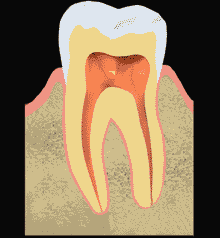Protect and keep a sick or dying tooth.
The Problem
- Infected or sick tooth due to decay or injury
- Chronic tooth pain from contact with hot and cold liquids
- Pain from pressure or biting down
- Danger of infection spreading

The Solution
Inside each tooth is a pulp chamber that contains the nerves and blood supply for the tooth. When the pulp becomes infected due to decay or injury to the tooth, the pulp must be removed from the center of the tooth and the canals of each root. Once the infected pulp is removed, the remaining chamber is cleaned and filled with a rubber-based material to seal it.
All teeth that have had root canal therapy must be protected with a tooth-like artificial covering known as a crown (see crowns). This is because teeth that have had the pulp removed no longer receive a blood supply or nutrients from our bodies and become brittle and more susceptible to fracture.
Root canal therapy has changed from methods of the past. Current root canals should be comfortable and most often completed in one visit.
Advantages
Root canal therapy is an excellent way to save a tooth that would otherwise die and need to be removed.
Disadvantages
If a tooth is sick, or infected there are no disadvantages to root canal therapy. On rare occasions, however, root canal therapy may need to be redone to ensure that all of the infection has been removed.
Alternatives
The only real alternative is to remove the sick tooth. However, this will require a dental implant or bridge to fill the empty space and prevent the shifting of surrounding teeth. These solutions will ultimately cost more than the root canal therapy, and even though they are wonderful ways to replace missing teeth, they will never equal the quality of keeping your natural tooth.
